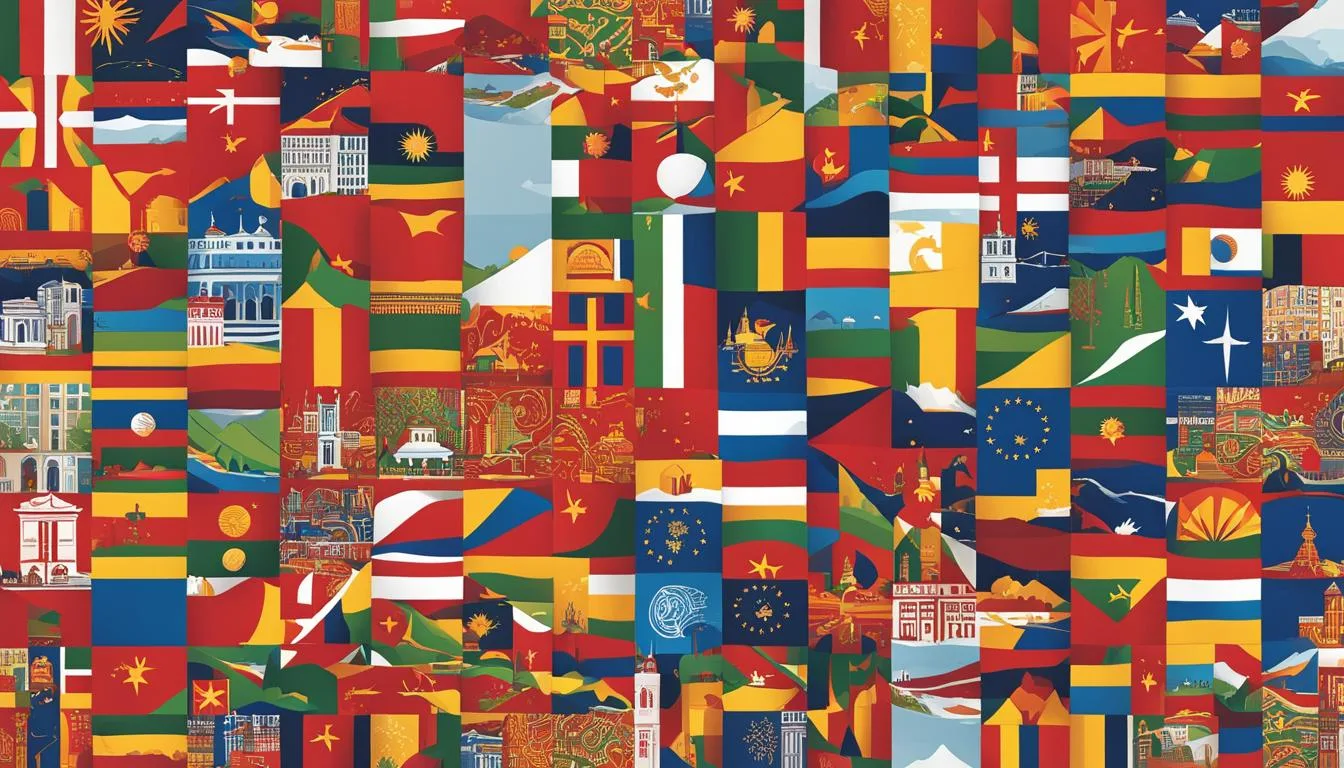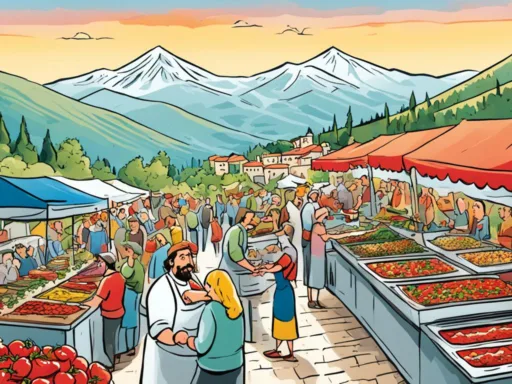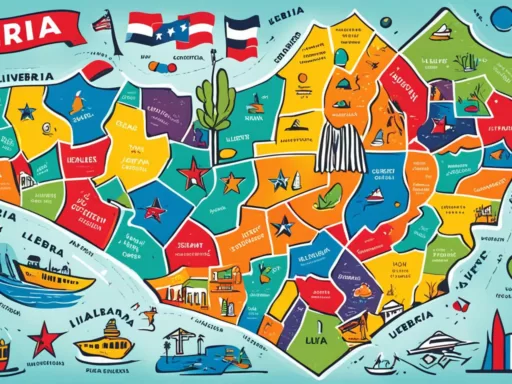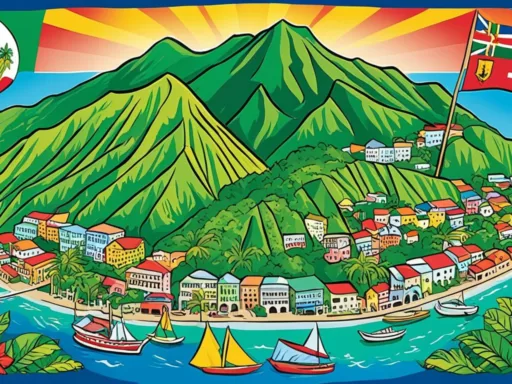Imagine a country small in size, yet so linguistically complex that over a dozen languages amble through its streets and whisper through its mountains. In the heart of the Balkans, North Macedonia stands as a testament to such diversity, with an impressive tapestry of languages spoken across its terrain. The languages spoken in North Macedonia are not just a mode of everyday communication; they represent the deep cultural tapestry woven over centuries. The Macedonian language, spoken by a majority, is complemented by the Albanian language, which enjoys co-official status and is spoken widely throughout the nation.
This intricate linguistic fabric includes a palette of minority dialects, while global tongues sprinkle the cosmopolitan hues over North Macedonia’s soundscape. North Macedonia might be small, but its linguistic richness and cultural depth are boundless, reflecting the country’s ongoing journey through history, culture, and societal cohesion.
Key Takeaways
- Macedonian serves as the lingua franca of North Macedonia, reflecting its historical journey and societal prominence.
- Albanian’s co-official status underscores the nation’s commitment to acknowledging its significant Albanian-speaking population.
- Minority languages, including Turkish, Romani, Serbian, Bosnian, and Aromanian, add vibrant threads to this cultural tapestry.
- Bilingual signage and legislative support demonstrate North Macedonia’s dedication to linguistic diversity and minority rights.
- The country’s linguistic landscape offers a glimpse into its cultural richness and the harmonious coexistence of its people.
The Official and Co-official Languages of North Macedonia
Nestled in the heart of the Balkans, North Macedonia is renowned for its linguistic diversity. The country’s approach to language speaks volumes about its cultural tapestry, with the Macedonian language as the cornerstone and the Albanian language acquiring a prominent role as a co-official language.
Macedonian as the Lingua Franca
Macedonian is the main linguistic thread weaving through the social fabric of North Macedonia. Serving not only as the lingua franca but also as an essential tool in international relations, its usage is widespread and significant. Nearly two-thirds of the populace converse in Macedonian, solidifying its place as an integral part of the nation’s identity.
Albanian’s Co-Official Status and Usage
Meanwhile, the Albanian language proudly claims its status as the co-official language, predominantly spoken in the western and northern regions. Highlighting the nation’s commitment to embracing its diverse demography, the 2019 legislation has empowered Albanian speakers by extending the use of their language nationwide in various administrative and public spheres alongside Macedonian.
| Language | Status | Regions of Prevalence | Usage in Public Administration |
|---|---|---|---|
| Macedonian | Official language | Nationwide | Primary language for all levels of government |
| Albanian | Co-official language | Western and Northern areas | Used on national level alongside Macedonian post-2019 legislation |
Linguistic Diversity: Minority Languages in North Macedonia
Embracing a collage of cultural identities, North Macedonia serves as a bustling harbor of linguistic variety. The nation’s eclectic linguistic portfolio extends beyond the official and co-official languages, acknowledging the prominent role and rich heritage of multiple minority languages that add to the social mosaic. These languages, each with its own historical significance and contemporary usage, underscore the country’s commitment to diversity and multiculturalism.
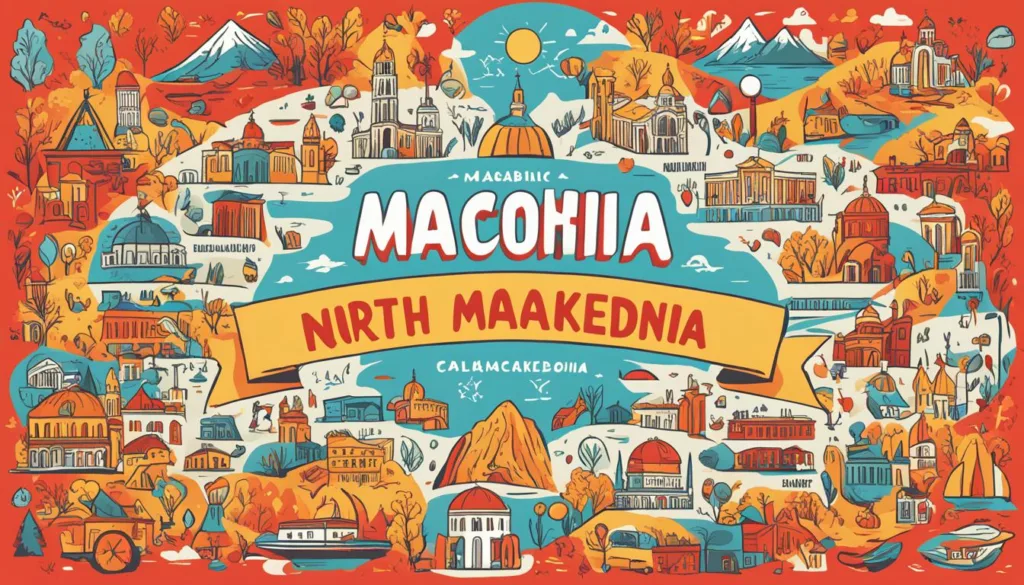
The Turkish Influence and Presence
The Turkish language stands as a testimonial to the enduring ties between North Macedonia and its historic Ottoman past. With co-official status in certain pockets of the nation like Plasnica and Centar Župa, Turkish boasts a vibrant community of speakers who maintain their linguistic traditions alongside modern dynamics.
Romani Language and Its Speakers
Similarly, the Romani language resonates through the bustling streets of Šuto Orizari, showcasing a unique linguistic identity. Noted for its Indo-Aryan roots, Romani finds its home amongst a sizeable demographic, representing one of Europe’s most widespread minority groups.
Serbian Linguistic Footprints
Despite not achieving an official status, Serbian language echoes in municipalities such as Staro Nagoričane and Čučer-Sandevo. These linguistic footprints mark a shared history and geographical proximity, contributing to the broader Serbian cultural influence within the country.
The Bosnian language’s Role
The Bosnian language further adds to the linguistic diversity, capturing the essence of cultural interchanges that have shaped the region over centuries. It is another strand in the rich tapestry of languages that North Macedonia honors and supports, acknowledging the Bosnian community’s contributions and their linguistic heritage.
Vlach and Aromanian Dialects
Completing this mosaic are the Vlach language and Aromanian dialects, each weaving its unique patterns into the cultural fabric. These linguistic threads maintain their vitality through oral traditions and community gatherings, reflecting the resilience and adaptability of the country’s linguistic diversity.
As North Macedonia continues to cultivate an environment of inclusion, the co-official status and embracement of these various languages not only preserve a legacy but also promote unity in diversity. The polyglot nature of this southeastern European nation indeed illustrates the rich complexities and affinities that comprise its societal core.
Languages Spoken North Macedonia
The complexity of the linguistic landscape within the borders of North Macedonia can hardly be overstated. Here, the linguistic map unfolds a vivid picture that is not only an essential part of the national identity but also an embodiment of multicultural interaction. Moving across the nation, one can witness the ubiquitous presence of bilingual signage, a tangible sign of the region’s commitment to linguistic diversity.
These bilingual signs typically showcase Macedonian and Albanian words, with a growing presence of English, reflecting North Macedonia’s strides in international engagement and tourism. Such practical demonstrations of linguistic inclusivity are more than a mere convenience for speakers of minority languages; they also act as a bridge that fosters better understanding and co-existence among communities.
According to the data drawn from the 2002 census, these signs do not merely represent political compliance but mirror the actual usage of languages across various regions. The prevalence of Macedonian is a given, but so is the extensive dissemination of other languages, particularly Albanian, that constitutes a significant portion of the day-to-day linguistic reality in North Macedonia.
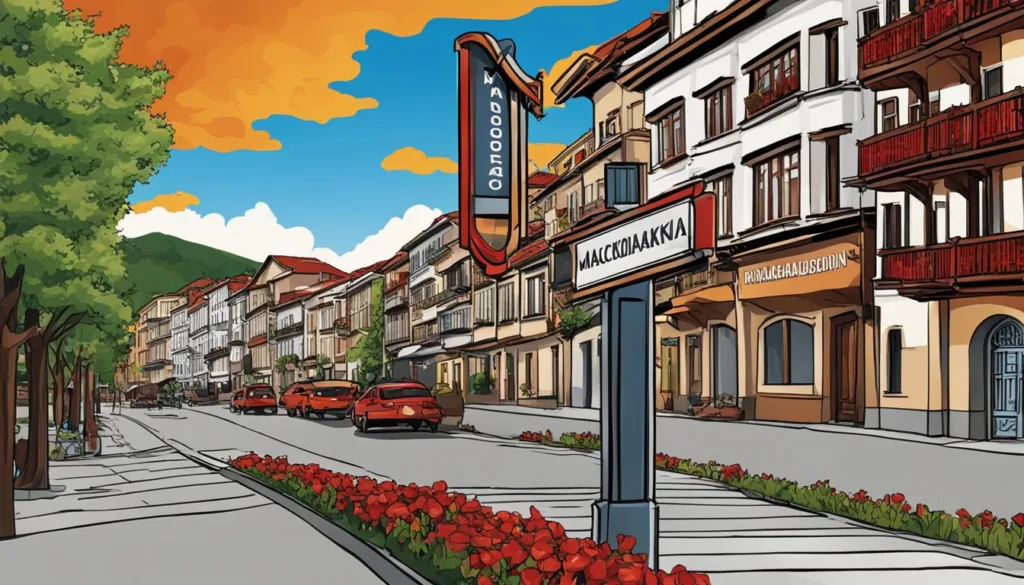
This presence of multiple languages spoken in North Macedonia is not an isolated phenomenon but is a reflection of the country’s rich history, where waves of empires and migrations have left indelible imprints on the cultural and linguistic fabric of the society. The dynamics of language usage and the areas where minority languages are predominantly spoken can be visualized through a linguistic map, which acts as an insightful tool for understanding the territorial distribution of these languages. Today, the linguistic map of North Macedonia does more than delineate geolinguistic boundaries; it tells the story of a nation that is both historically rooted and forward-looking in its embrace of a multilingual future.
Macedonian Language: A Historical Overview
The Macedonian language stands as a testament to a rich historical journey which anchors its place among the South Slavic languages. The evolution of Macedonian showcases a fascinating interplay between culture, interaction, and linguistic identity. Traced back through the annals of history, the linguistic narrative of Macedonian is not just about communication but also about the assertion of national identity and the very sense of being that defines a people.
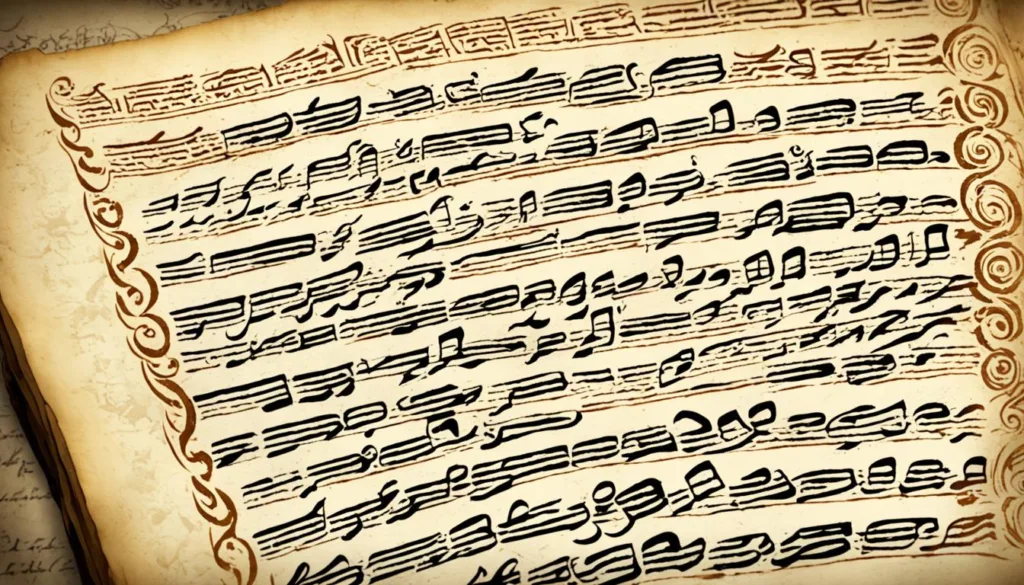
Development of the Macedonian Linguistic Identity
The roots of the Macedonian linguistic identity stretch far beyond the period of its standardization. Originating from the western dialects of the East South Slavic dialect continuum, Macedonian developed its distinctiveness through centuries of cultural influences and political changes that swept through the region. This identity was further crystallized in the 19th and early 20th centuries as Macedonian intellectuals began to foster a sense of national consciousness through language.
Codification and Standardization of Macedonian
The formal journey towards the standardization of the Macedonian language began in earnest after World War II. It was in 1945 that a significant milestone was reached with the codification of the language, a pivotal moment that would pave the way for a thriving literary tradition to emerge. This process involved the systematic organization of grammar, spelling, and vocabulary that established Macedonian not just as a dialect but as a standardized language with international recognition. By embracing its linguistic heritage and delineating its unique characteristics, Macedonian has cemented its role as the official language of North Macedonia and a symbol of its national identity.
Albanian Language Influence and Distribution
The presence of the Albanian language in North Macedonia is historically and culturally significant, extending influence beyond the borders of Albanian-speaking regions. With the advent of inclusive language laws, the scope for communication and education in Albanian has broadened, positioning it as a pillar of bilingual education initiatives. This linguistic dynamic facilitates a better understanding and appreciation of the cultural diversity within the country.
Albanian-Speaking Regions Within North Macedonia
In North Macedonia, the Albanian language flourishes predominantly within the western and northern locales. Municipalities like Tetovo, Gostivar, and Struga form the heartland of Albanian-speaking communities, characterizing these areas with a vibrant bilingual fabric. The distribution of the Albanian-speaking population underscores the rich cultural tapestry and necessitates educational frameworks to cater to bilingual needs.
Status and Rights of Albanian Language Speakers
Albanian language speakers enjoy comprehensive rights and status, especially following the legislation passed in 2019. This legal framework ensures that the Albanian language is not just a regional vernacular but an integral part of national discourse, affirming its co-official status and cementing its role in public administration, judiciary, and education across North Macedonia.
| Municipality | Percentage of Albanian Speakers | Bilingual Education Availability |
|---|---|---|
| Tetovo | 70.3% | Widespread |
| Gostivar | 66.7% | Widespread |
| Struga | 56.8% | Available |
| Debar | 58.1% | Available |
| Kičevo | 50.8% | Available |
The Role and Recognition of Turkish in North Macedonia
The Turkish language has threaded its way through the very fabric of North Macedonia’s cultural heritage, bearing witness to both historical significance and contemporary relevance. With a robust number of speakers and official recognition in multiple municipalities, Turkish is not only a means of communication but also a living reminder of the nation’s vibrant past and its diverse present.
Geographical Distribution of Turkish Speakers
Intricately woven through the demographic quilt of North Macedonia, Turkish speakers are predominantly found in areas where they form a sizeable community. These geographical locales showcase the integration of the Turkish language into the societal vernacular, further solidifying its co-official status granted in certain regions.
Historical Ties and Cultural Impact of Turkish
Traces of the Ottoman empire resonate through the linguistic landscapes of North Macedonia, where the Turkish language serves as a bridge between epochs. Its cultural influence extends beyond mere speech, coloring the nation’s traditions, cuisine, and artistic expressions, hence contributing to an enriched, multicultural society.
| Municipality | Percentage of Turkish Speakers | Co-official Status |
|---|---|---|
| Centar Župa | ~20% | Yes |
| Plasnica | ~40% | Yes |
| Strumica | ~5% | No |
| Gostivar | ~15% | Yes |
The geographical distribution and historical ties of the Turkish language echo the enduring interplay between cultures that has long been a hallmark of this region. Its official recognition underscores an enduring legacy which continues to shape the linguistic and cultural contours of North Macedonia.
Understanding the Romani Language in North Macedonia
The Romani language is an integral part of North Macedonia’s linguistic diversity. Originating from the Indo-Aryan grouping of languages, it boasts a wealth of dialects collectively known as Balkan Romani. The presence of the Romani community in North Macedonia is not only a testament to cultural richness but also to the nation’s acknowledgment of its diverse linguistic fabric.
In the heart of the Balkans, Romani speakers in North Macedonia engage with a language that has historically had an itinerant path, passing through different regions and cultures, consequently absorbing and integrating a myriad of linguistic features. It’s a language that’s both rich and complex, often reflecting the migrations and storied history of the Romani people themselves.
One municipally where the Romani community has left an indelible mark is Šuto Orizari, also known as Shutka. Here, Balkan Romani is not only recognized officially but is also cherished as an everyday language of business, education, and media, providing a glimpse into the linguistic vibrancy within North Macedonia.
- A language of pride in Šuto Orizari, where the majority of Romani speakers live.
- Varied dialects contributing to a linguistic tapestry within a single community.
- Linguistic diversity enhanced by formal recognition and educational programs.
Exploring the linguistic tapestry we find in North Macedonia today, the Romani language is a symbol of inclusion and a reminder of the importance of preserving linguistic heritages. It serves as a key component of a broader societal embrace of culture and identity – a conversation continued in every phrase and sentence exchanged on the streets where Balkan Romani thrives.
Patterns of Multilingualism and Language Policy
In the heart of the Balkans, North Macedonia’s heritage of multilingualism is a testament to its social and cultural intricacies. With an education policy that emphasizes the importance of not only the majority language but also minority tongues, the nation sets an example on acknowledging linguistic diversity.
Language Rights and Education in Minority Languages
Underpinning the mosaic of languages, North Macedonia’s language rights are enshrined within its constitutional framework. Such provisions ensure that communities can flourish within their cultural identities, with an education policy affording schooling in the languages of the minority population clusters.
Every individual’s language is his or her touchstone to history and culture; a right – not merely a privilege – to be fully honored in both personal and legislative realms.
Implications of Multilingual Policies for National Unity
The ripple effects of an inclusive language policy are profound, conveying a message that every dialect and vernacular has a space to coexist, thus harmonizing multiethnic ties and reinforcing the bedrock of national unity.
| Language | Percentage of Speakers | Education Policy Support | Official Use |
|---|---|---|---|
| Macedonian | 66% | Yes | National & Local |
| Albanian | 25% | Yes | Co-official |
| Turkish | 3% | Yes | Local (where applicable) |
| Romani | 1.5% | Yes | Local (where applicable) |
| Serbian | Minor | Selective support | Local (where applicable) |
Conclusion
In the heart of the Balkans, the linguistic landscape of modern Macedonia reveals a rich tapestry where tongues from varied heritages converse in harmony. A crossroad of civilizations throughout history, North Macedonia today stands as a testament to how linguistic variety forms a cornerstone of a nation’s identity. The official status of the Macedonian language, the co-official role of Albanian, and the presence of an array of minority languages emphasize a societal embrace of cultural heritage and inclusivity.
Modern Linguistic Landscape of North Macedonia
Through this prism of linguistic plurality, modern Macedonia renews its social fabric, ensuring that every voice – from the major Macedonian-speaking populace to the smallest of minority language groups – finds resonance in the public sphere. Such policy is not merely about maintaining communication but about preserving a living, breathing mosaic of human expression that has evolved across centuries.
Importance of Linguistic Diversity to Cultural Heritage
The recognition and preservation of this linguistic diversity are not solely acts of cultural homage but are proactive steps towards fortifying the nation’s cultural richness. Embracing the multitude of languages that compose the nation’s dialogue is a form of respect to a collective history and a commitment to a more unified and cohesive society. Thus, North Macedonia serves as an example of how a linguistic heritage can be both celebrated and utilized as a tool for societal cohesion and shared identity.

